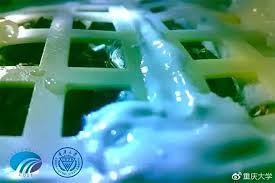
Breaking News
 2 Hours of Retro Sci-Fi Christmas Songs | Atomic-Age Christmas at a Snowy Ski Resort
2 Hours of Retro Sci-Fi Christmas Songs | Atomic-Age Christmas at a Snowy Ski Resort
 Alternative Ways to Buy Farmland
Alternative Ways to Buy Farmland
 LED lights are DEVASTATING our bodies, here's why | Redacted w Clayton Morris
LED lights are DEVASTATING our bodies, here's why | Redacted w Clayton Morris
Top Tech News
 Travel gadget promises to dry and iron your clothes – totally hands-free
Travel gadget promises to dry and iron your clothes – totally hands-free
 Perfect Aircrete, Kitchen Ingredients.
Perfect Aircrete, Kitchen Ingredients.
 Futuristic pixel-raising display lets you feel what's onscreen
Futuristic pixel-raising display lets you feel what's onscreen
 Cutting-Edge Facility Generates Pure Water and Hydrogen Fuel from Seawater for Mere Pennies
Cutting-Edge Facility Generates Pure Water and Hydrogen Fuel from Seawater for Mere Pennies
 This tiny dev board is packed with features for ambitious makers
This tiny dev board is packed with features for ambitious makers
 Scientists Discover Gel to Regrow Tooth Enamel
Scientists Discover Gel to Regrow Tooth Enamel
 Vitamin C and Dandelion Root Killing Cancer Cells -- as Former CDC Director Calls for COVID-19...
Vitamin C and Dandelion Root Killing Cancer Cells -- as Former CDC Director Calls for COVID-19...
 Galactic Brain: US firm plans space-based data centers, power grid to challenge China
Galactic Brain: US firm plans space-based data centers, power grid to challenge China
 A microbial cleanup for glyphosate just earned a patent. Here's why that matters
A microbial cleanup for glyphosate just earned a patent. Here's why that matters
 Japan Breaks Internet Speed Record with 5 Million Times Faster Data Transfer
Japan Breaks Internet Speed Record with 5 Million Times Faster Data Transfer
A Chinese engineer reveals how he grew the FIRST EVER plant on the MOON using a mini-biosphere...

This week at London's Design Museum, one of the engineers behind the historic Chang'e-4 mission to the moon gave a demonstration of the spacecraft's 'mini-biosphere' where he and his team helped germinate the first seed ever on the moon.
The presentation, delivered by Xie Gengxin of Chongqing University, was part of the museum's 'Moving to Mars' exhibit showcasing a range of different technologies that will allow humans to survive long term in space and on other planets.
While previous groups had grown small plants on the International Space Station, which is in orbits the Earth some 250 miles above the surface, no one had yet accomplished the feat on the moon.
Xie and his team devised a cylindrical garden capsule to try and bring gardening deeper into outer space.
The capsule stood around 8 inches tall with a 6.5 inch diameter and had a rectangular seed bed that was loaded with cotton, potato, rape seeds, a variety of weed called Arabidopsis, and fruit fly eggs.

 $100 SILVER CONFIRMED?
$100 SILVER CONFIRMED?

